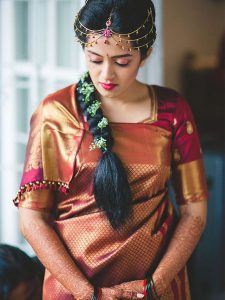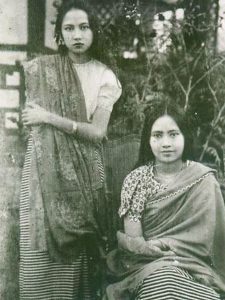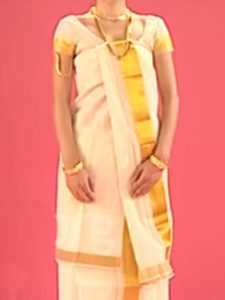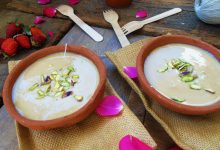There are more than 80 recorded ways to wear a sari. Here’s the second and final part of the erudite article that discusses the major styles, says, fashionista Shameena, in the weekly column, exclusively for Different Truths.
A drape that is primarily worn by the Golla (shepherd) and the Gudati Kapulu (agriculturist) communities of Narasannapalle, a village in the Kadapa district of Andhra Pradesh. Though the drape begins like a normal nivi drape, once the pleats are made, they are twisted around the body and tucked at the waist from the other end instead of the front. The pleats are rolled outwards and secured by wrapping them over with the innermost layer. The lower borders are picked then at the two extremes and brought to the waist at the back from either side to be tucked in. This requires a material like silk which can hold the shape for long hours.
Seedha Pallu from Gujarat, UP, and Odisha
An everyday sari draping style in Gujarat, Uttar Pradesh and Odisha, this sari drape resembles a lehenga-choli where the pallu of the sari is used in place of the dupatta. This permits immense freedom of movement and works very well for heavy saris where the shoulder doesn’t have to carry the weight of the heavily worked pallu. The pallu in the front is perfect for demonstrating the intricate work on the pallu and the border.
Surguja from Chhattisgarh
One of the most elegant ways of draping a sari, this style is worn by the dancers of the Oraon community of Chattisgarh. A 5.3-yard sari is used to create a stand out whirling effect at the end. The loose ends are tucked in the front and the back as it permits immense freedom of movement to the dancers.
Pinkosu from Madurai
This incredibly elegant style is worn by women in Tamil Nadu. Perfect for the hot weather, this style can be worn without a petticoat. The term pinkosu means “pleats at the back”. The drape is wrapped 1.5 times around the body, for more coverage. The pleats will fall towards the outside of the wrap, unlike nivi style. Therefore, the underside of the sari will be showing. Keeping this in mind, a sari must be chosen accordingly. Homespun handloom cotton saris work very well as they are reversible.
Bootheyara from Karnataka
Ceremonial performers of nomadic origin are associated with this style. Draped from an 8-yard sari, this can be used either as a one-piece lower pant style drape, or a two-piece drape which involves a shawl to cover the bust, depending on the comfort of the wearer. The best sari for this style is a cotton or a cotton-silk blend sari.
Coorgi style from Karnataka
The Coorgi style finds a mention in a popular story of Kaveri and Agastya. This draping style evolved to help Coorgi women lead an active life — climbing the hilly slopes of the Western Ghats and trees on a daily basis. Traditionally, paired with a full sleeved blouse, this style has pleats at the back. The end of the sari is brought below the left shoulder, and secured over the right shoulder in a firm knot called ‘molakattu’. Today, the red and gold silk Kanjeevaram is worn in the Coorgi style by brides during the wedding ceremony.
Halakki Vokkaliga from Karnataka
Living at the base of the Western Ghats in Karnataka, they are popularly called the aboriginals of Karnataka. With hundreds of years of legacy behind them, they have distinct cultural practices. One of the most distinguishing features is the way the womenfolk drape their sari. They wear the sari is tied around the neck and wrapped around the body like a sarong, making a blouse or petticoat unnecessary. These women accessorise themselves with colourful beads and flowers and have a vivacious personality.
Gol Sari (Parsi drape)
The simple, but elegant Parsi drape is worn by most Parsi women during festivities, and even on a regular basis. Parsi women begin wearing a sari after the Sari Perawan ceremony, which is a rite of passage ceremony. Most Parsi women prefer a light chiffon or georgette sari for this drape. Called a gara, the pallu is taken from behind and draped over the blouse. It hangs in loose folds over your left shoulder. It is brought over the right shoulder and the folds are splayed out in front. The front of the pallu falls close to the hem.
Kunbi drape from Goa
An ancient style, the kunbi way of draping a sari was followed by tribal women in Goa much before the advent of the Portuguese in the 16th century. An extremely basic style which involved wrapping the sari around the waist and knotting it over the right shoulder, it facilitated working in the paddy fields. This sari was tied a little above the ankles and did not necessitate the use of a blouse or petticoat.
Madisaru from Tamil Nadu
A very important part of the Iyer and Iyengar culture of Tamil Nadu, the Madisaru was worn by women, traditionally after marriage. Today, however, this sari drape is sported on special occasions and festivities. One of the toughest styles to drape, if worn properly, it does not require the use of a blouse or a petticoat. It follows the Ardhanareeshwara style of draping, meaning half man and half woman; the lower half is draped like a dhoti while the upper half is pleated like a sari.
Santhal Drape from Jharkhand
Traditional Santhal saris are characterised by their chequered pattern. One of the simplest saris to drape, it has evolved over the years with an improvement in the economic status of the tribe. Very similar to the Bengali drape, it has a box pleat at the front and the pallu is pulled over the left shoulder in a big triangle. The rest of the pallu is tucked in the front. This style is extremely simple and free, just like the lifestyle and thought the process of the Santhali people.
Phanek and Innaphi from Manipur
The Phanek and Innaphi form the traditional clothing of Manipuri women. The Phanek is the ethnic sarong worn by Manipuri women and is broadly of two types – the Meitei Phanek and the tribal Phanek. Inaphi literally translates into a wrap for the upper body. The Phanek is usually horizontally striped and has a floral border typical to the tribe that has created it. The Inaphi has delicate floral designs on it and is worn like a dupatta.
Namboothiri from Kerala
The Namboothiri is the oldest remnant of a sari worn in Kerala, which used to cover only the lower part of the body. The mundum neriyathum is a combination of the mundum, or the lower garment and the neriyathum or the upper garment. The latter is tucked inside the blouse or thrown over the left shoulder. In modern parlance, this form of the sari is rarely worn and is reserved for folk dances during festivals like Onam.
(Concluded)
©Shameena Abdurahiman
Photos from the Internet, sourced from the author
#Sari #WearingSari #DrapingSari #DifferrentWayToDrapASari #IndianDress #UnstichedClothing #IndianCulture #FashionFunda #DifferentTruths



















 By
By

